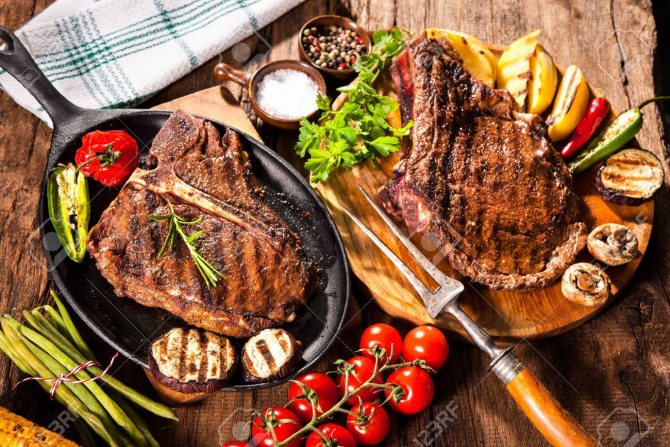Instructions and tips for properly frying a steak. Frying the perfect steak is a mystery to many chefs. With our practical instructions and numerous tips, every steak is just right, just the way the guest wants it.
Fry the steak properly
If you want to sear a steak properly, there are a few things to keep in mind. You should not only pay attention to the right temperature and frying time. The quality of the meat and the pan can also be important for a successful result. Individual wishes and tastes should also be taken into account. Because not everyone likes their steak “well done”. Thus, the preparation of a steak seems like a big challenge to some. But don’t worry, with the following tips you will succeed in frying the steak:
1) Know the most common types of steak

Finding the right meat for a steak is not always easy. With beef steaks, a distinction is made between the different parts of the animal. The most common types of steak are rib-eye steak, fillet steak, rump steak, T-bone steak, porterhouse steak, rump steak, sirloin steak, flank steak, and boiled beef. The difference lies in the fat and bone content and the size of the meat piece. In addition, a fillet steak, for example, is far more tender than a T-bone steak, which has more roast beef than a fillet.
2) Buy the right meat
For a real gourmet steak, it is advisable to choose a flank steak, rump steak, or fillet steak. In any case, the meat should be tender and juicy. Depending on your taste, you should cut the steaks at least 2 cm and at most 4 cm thick. It is advisable to buy the meat fresh from the butcher or at the meat counter in the supermarket. Because ready-packaged steaks are not necessarily cheaper, they are far behind freshly cut meat in terms of quality. Also, note how you can identify and preserve fresh fish.
3) Fry the steak properly in the pan
A cast-iron grill or frying pan, which ideally can be used on a gas stove, works best. Of course, ceramic hobs and induction cookers are also suitable for frying. In the summer season, a charcoal grill is recommended, because it can generate enough heat and is also really fun. Also, read delicious menu ideas for grilling. Meanwhile, cast aluminum pans are more suitable for low frying temperatures, as coatings may otherwise come off. This is not a problem but takes longer.
4) Which fat to use for frying?
Butter, peanut oil, or rapeseed oil are particularly suitable as fat. Because these have a high smoke point, which is not the case with olive oil or butter, for example. At high temperatures, bitter substances can be released here. And you should avoid that when frying your steak properly. In addition, you can freeze and thaw meat well, so that leftovers do not have to be thrown away.
5) Tips on preparing to fry steak
The steak should always be at room temperature before frying. To do this, take the meat out of the fridge early enough. Half an hour before cooking is usually sufficient. If the steak is to be pulled into the oven, the oven must first be switched on at a maximum of 160 degrees circulating air or top and bottom heat. Cooking the steak in the oven at lower temperatures will make it more tender. However, it takes longer accordingly. Read also how you can then remove the oven smell.

There are two ways to prepare meat. Either the fat is added to the pan or it is massaged into the meat beforehand. In the latter process, you should let the meat rest for 10 minutes after massaging it. The pan must be heated to a high temperature before frying. If you put a drop of water in the pan, it must immediately evaporate. Then you know that the right temperature has been reached.
6) What cooking levels are there?
Cooking is an important issue when frying a steak properly. Depending on your taste and preference, you can choose between different cooking levels. And depending on the degree of doneness, a different core temperature is required. It is advisable to place the steak in the preheated oven after searing. Depending on the thickness of the meat and how well done you want it to be, the cooking time in the oven can range from 5 minutes to an hour if you prefer the slow cooking method. It is important to know that a steak becomes more tender the longer it is cooked at low temperatures.
7) The perfect cooking point and the perfect cooking time
You should always ask guests in advance how they want their steak. And then pay attention to the respective core temperatures during preparation. Then you need to sear the steak for a minute on each side. This creates a delicious crust and the meat’s own juices remain in the steak. So it doesn’t get dry.
You can use the finger test to determine the doneness. Because you can estimate the degree of doneness on the heel of your hand. If you hold your hand loosely and press on the heel of your hand, it feels like a steak that has been “rare” cooked. “Medium” corresponds to the firmness of the heel when you hold your thumb and middle finger together. A steak feels “well done” like the heel of a hand when the thumb and ring finger are held together. A little helper in the kitchen is useful for the cooking time in the oven – a roasting thermometer.














